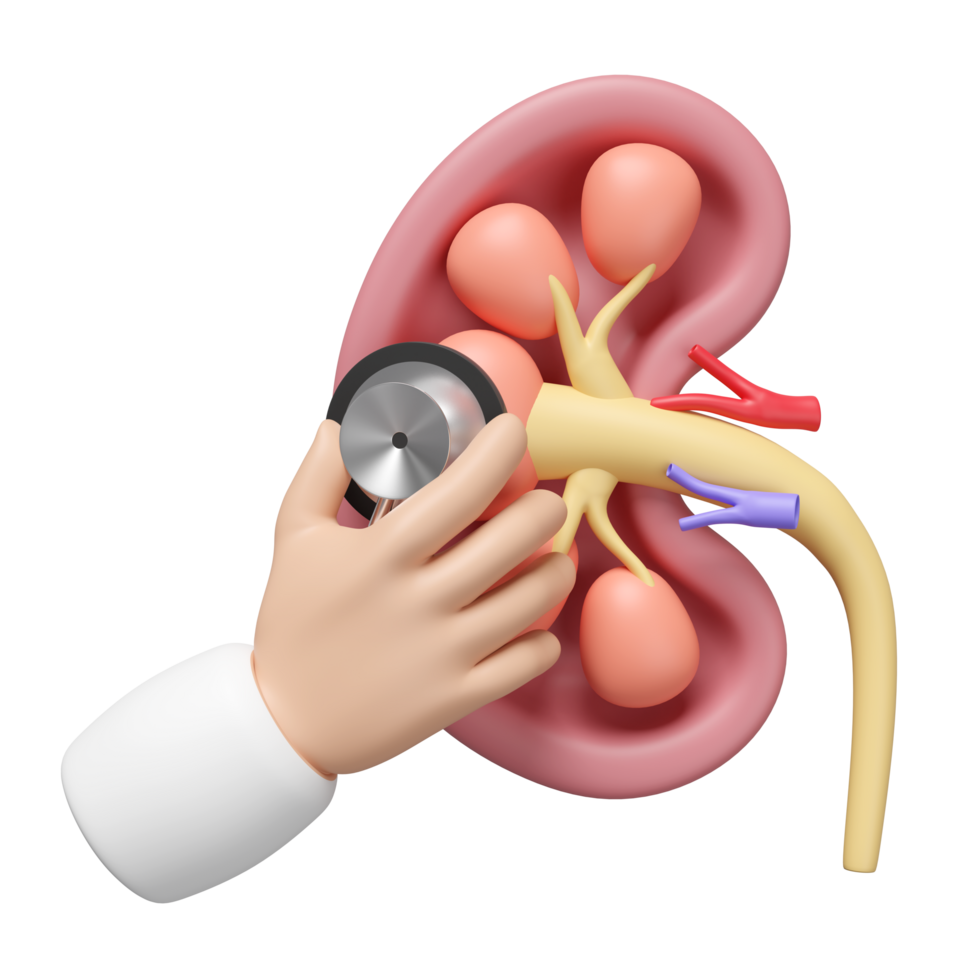Restoring Health, Reviving Lives
At Surya Kidney Centre, we understand how health issues can impact your daily life. Whether you’re dealing with kidney-related conditions or other urological concerns, our dedicated team of specialists is here to provide compassionate and comprehensive care. We are committed to helping you regain your well-being and live life to the fullest.
BLADDER CANCER
The bladder* is where urine is stored before it leaves your body.Urine is the liquid waste made by your kidneys.
Sometimes our body cells do not behave in the orderly way they should.This abnormal growth is cancer.Bladder cancer is cancer that begins in the bladder.A person with bladder cancer has one or more growths or tumors (lumps) made up of abnormal and unhealthy cells.
• Non-muscle invasive bladder cancer (NMIBC) is cancer that grows only in the thin tissue on the inside surface of the bladder.With NMIBC, the bladder muscle is not involved and the tumor is unlikely to spread outside the bladder.There are many options for treatment.
• Muscle-invasive bladder cancer (MIBC) is a cancer found in the thick muscle of the bladder wall.It is a serious and more advanced stage of bladder cancer.MIBC should be treated without delay.
What Causes Bladder Cancer?
Smoking is a big risk factor
• Genetics as there may be a link within your family
• Cyclophosphamide, a cancer drug
• Radiation to the pelvis
• Workplace exposure to chemicals used to make plastics, paints, leather and rubber
How does Bladder Cancer Grow?
The bladder wall has several layers, made up of different types of cells.Most bladder cancers start within the inside lining of the bladder, not in the bladder muscle.NMIBC does not grow beyond the bladder lining.
Bladder cancer can get worse if it grows into or through other layers of the bladder wall; then it is called muscle-invasive bladder cancer (MIBC).MIBC starts in the inner bladder layers and then grows into the deep muscle.Over time, the tumor may grow outside the bladder into tissues close by.The cancer may then spread to lymph nodes, the lungs, the liver and other parts of the body.
What are the Symptoms of Bladder Cancer?
Some people may have symptoms of bladder cancer.Others may feel nothing at all.Talk with your health care team if you have any of these signs or symptoms:
• Blood in the urine, or hematuria
• Frequent and urgent need to pass urine
• Pain when you pass urine
• Pain in your lower abdomen
• Back pain
Blood in the urine is the most common sign of bladder cancer.You may have it and feel no pain.Often, you cannot see blood in your urine without a microscope.If you can see blood in your urine, do not ignore it.Tell your health care team right away, even if the blood goes away.
Blood in the urine does not always mean you have bladder cancer.There are many reasons why you may have blood in your urine.Tests can show if you have a urinary tract infection or something more serious, like bladder cancer.
What Tests are used for Bladder Cancer?
Imaging Tests for Bladder Cancer
Imaging plays a key role in both the diagnosis and follow-up care for bladder cancer. It is used to stage the cancer, check how it may spread, watch for how treatment is working and/or detect if the cancer has come back after treatment. Imaging for bladder cancer may include:
• CT (Computed Tomography) Scan of the chest, abdomen and pelvis with intravenous contrast is the standard approach. It helps to assess the size and extent of the tumor and check for any spread to nearby organs, lymph nodes or distant sites like the lungs.
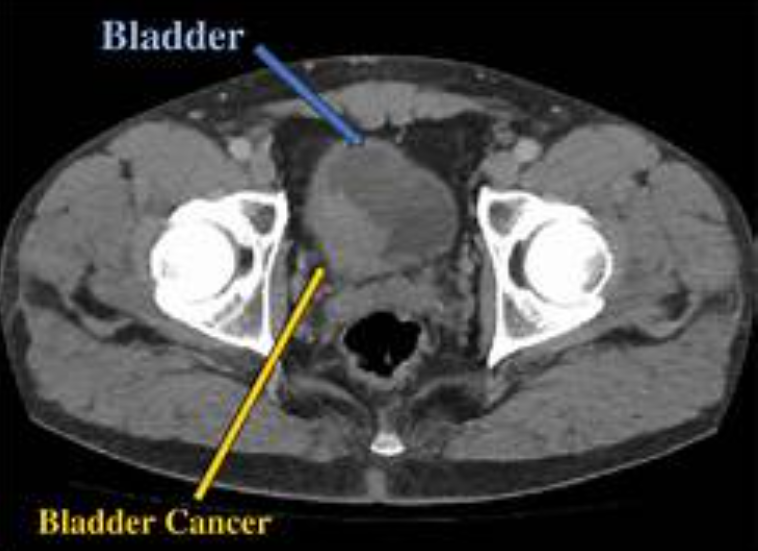
If your health care provider believes you may have bladder cancer, then they may ask you to see a urologist. Your urologist may do a full medical history and physical exam. Further tests may include the following:
Focused Tests for Bladder Cancer
• Urinalysis, a urine cytology, is a urine lab test to check for cancer cells.
• Cystoscopy lets your doctor see inside your bladder. Your doctor will pass a tube (cystoscope) through your urethra into your bladder. The tube has a light at the end so your doctor can see the inner layer of your bladder clearly. There are two types of cystoscopy procedures:
–Flexible cystoscopy, where the doctor uses a thin cystoscope that can bend. This will most likely be done in the office with local anesthesia to look for an unusual lump or to perform a biopsy.
–Rigid cystoscopy, where the doctor uses a bigger, straight cystoscope that has space for instruments to pass through. This allows them to take samples or resect (cut away) the tumor. Usually, you will be put to sleep in the operating room so that you will not feel what is happening.
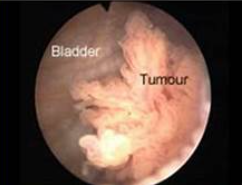 Cystoscopy Image Showing Bladder Tumour
Cystoscopy Image Showing Bladder Tumour
Transurethral resection of bladder tumor (TURBT) is a surgery that may be done during rigid cystoscopy as part of your diagnosis.
CT Scan Showing Bladder Cancer
GET TREATED
Your treatment choices will depend on your cancer stage and how much your cancer has grown.Treatment also depends on your general health and age.
What are the Treatment Choices for Bladder Cancer?
Non-muscle Invasive Bladder Cancer Treatment
There are three main treatments for NMIBC as listed below. If these methods do not have good results, your doctor may recommend removing your bladder.
• Cystoscopic transurethral resection of the bladder tumor (TURBT)
• Intravesical immunotherapy
• Intravesical chemotherapy
Muscle-Invasive Bladder Cancer Treatment
There are two options for treating MIBC as listed below.
• Bladder removal (radical cystectomy) with or without chemotherapy. A less common option is partial cystectomy to remove part of the bladder.
• Trimodal Therapy with chemotherapy and radiation, in addition to TURBT.
TURBT
TURBT is done through the urethra using a cystoscope, so there is no cutting into your abdomen.You will be put to sleep, or you may get medication in your spinal cord to dull the nerves in your lower back.Your doctor will use a rigid cystoscope to look inside your bladder, take tumor samples and resect (cut away) all of the tumor that can be seen.
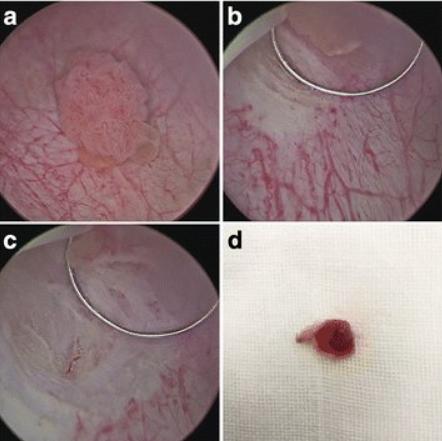
TURBT Procedure
Partial Cystectomy
For partial cystectomy, the doctor removes only part of your bladder. Your doctor may offer partial cystectomy in only select cases of bladder cancer, when the tumor is in a specific part of the bladder and does not involve more than one spot in the bladder.
• Radical Cystectomy
A radical cystectomy is when your whole bladder is removed. For NMIBC, radical cystectomy is usually done if other therapies fail. For MIBC, radical cystectomy is the most common surgery. During this surgery, the doctor will remove:
- The entire bladder
- Part or all of the urethra
- Nearby lymph nodes
- The prostate (in men)
- The uterus, ovaries, fallopian tubes and part of the vagina (in women).Other nearby tissues may also be removed or in some cases, these organs will remain in place.
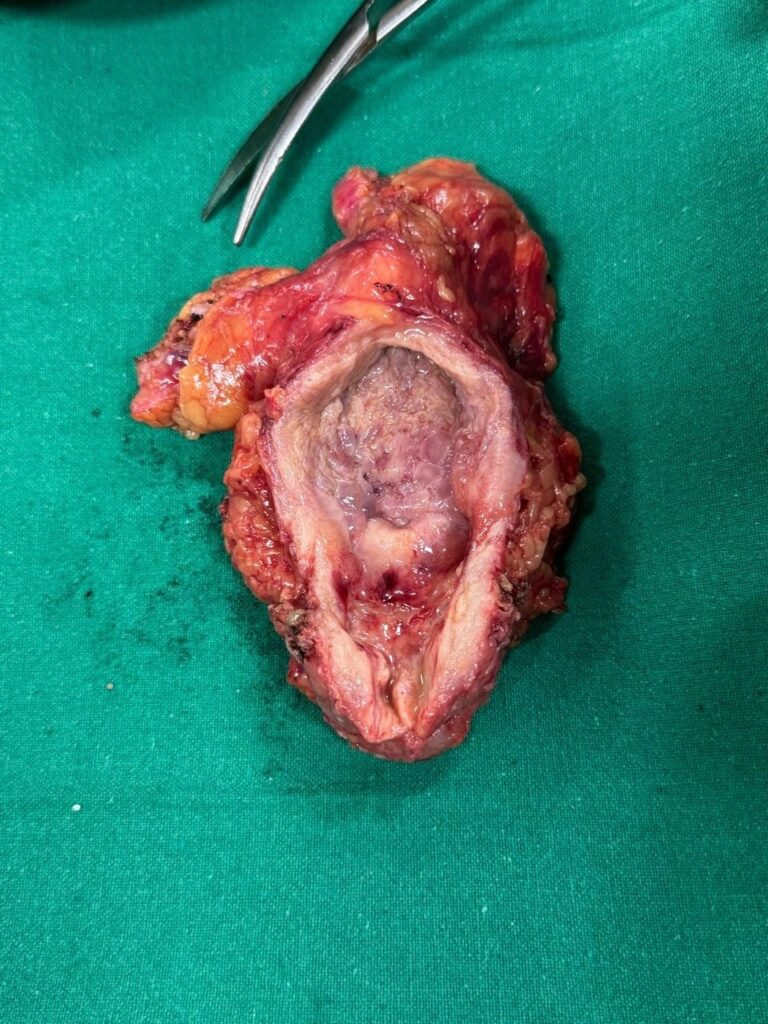
Specimen showing carcinoma bladder
What Takes Place Following Treatment?
Be sure to maintain communication with your medical team.
Following Non-muscle Invasive Bladder Cancer Treatment
If you have low risk, follow-up cystoscopy, your doctor might want to see you in three to four months. This enables your physician to determine whether the tumor has reappeared. Your risk of recurrence determines how frequently you should see your physician.
• If the danger is modest, your doctor might urge you to come back for a cystoscope examination in three months.
• If you have moderate (medium) risk, you might be requested to come in for a cytology and cystoscopy every three to six months for two years, then every year after that.
• If you have high risk Your doctor might recommend that you return every three to four months for two years, then every six months for three to four years, and then annually after that if you are considered high risk.
After treatment for MIBC, you should expect to return to your doctor regularly. Follow-up is not the same for all people. But, follow-up may include some or all of the following:
• Imaging (e.g. CT scan) about every three to six months for two to three years, and then once a year.
• Laboratory tests may be every three to six months for two to three years, and then once a year. Kidney and liver function tests will be a part of these tests.
• Assessment for quality of life issues, such as urinary symptoms and sexual function.
If you had bladder removal surgery, it takes time to heal.The time needed to recover is different for each person.It is common to feel weak or tired for a while.Like any other major surgery, bladder surgery may have complications.
There are things you can do to help you feel better. If you smoke, get help to stop. With your doctor’s approval, start exercising and eating more fruits and vegetables. Healthy eating may help you recover faster. Your health care team may also recommend a cancer support group or counseling.
Why Choose Us?
Experience and Expertise
Advanced Technology
Personalized Evidence based Treatment
Honesty and Integrity
Affordable Treatments

